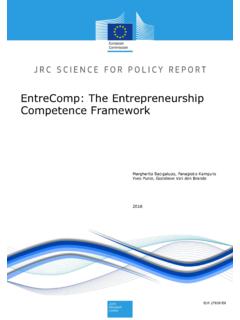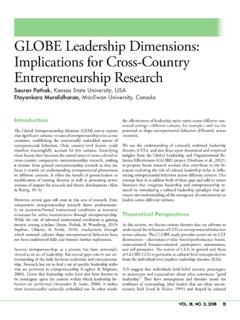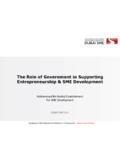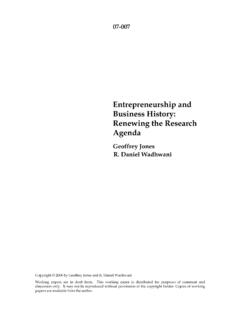Transcription of YOUTH ENTREPRENEURSHIP - OECD
1 YOUTH . ENTREPRENEURSHIP . Prepared by Francis Green A background paper for the OECD Centre for ENTREPRENEURSHIP , SMEs and Local Development This work is published on the responsibility of the Secretary-General of the OECD. The opinions expressed and arguments employed herein do not necessarily reflect the official views of the Organisation or of the governments of its member countries. This document and any map included herein are without prejudice to the status of or sovereignty over any territory, to the delimitation of international frontiers and boundaries and to the name of any territory, city or area. The statistical data for Israel are supplied by and under the responsibility of the relevant Israeli authorities. The use of such data by the OECD is without prejudice to the status of the Golan Heights, East Jerusalem and Israeli settlements in the West Bank under the terms of international law.
2 Cover prepared by Fran ois Iglesias (OECD/LEED). OECD 2013. You can copy, download or print OECD content for your own use, and you can include excerpts from OECD publications, databases and multimedia products in your own documents, presentations, blogs, websites and teaching materials, provided that suitable acknowledgment of the source and copyright owner is given. All requests for public or commercial use and translation rights should be submitted to Requests for permission to photocopy portions of this material for public or commercial use shall be addressed directly to the Copyright Clearance Center (CCC) at or the Centre fran ais d'exploitation du droit de copie (CFC) at Section 1: Introduction Many young people in the OECD and the EU cannot find employment.
3 This has become particularly acute since the onset of the financial crisis in 2008. EU figures suggest that around one-in-five young people in the EU were unemployed in 2011 whilst YOUTH unemployment in countries such as Greece and Spain was over 40 per cent (Eurostat, 2011). In very many OECD countries, YOUTH unemployment is either at, or close to the maximum level, ever experienced (OECD, 2010: 29) 1. The OECD also notes that the NEET population (those not in education, employment or training) has grown, on average, by more than 2 per cent across the OECD over 2008-2010 so that NEETs constitute around one in eight of young adults (OECD, 2010: 42) 2. These outcomes are both inefficient and inequitable. Evidence shows that the unemployed are unhappier, more likely to experience a range of health issues, and face difficulties in integrating back into the labour market place (Bell and Blanchflower, 2009).
4 For young people, the effects of unemployment may be particularly scarring. Evidence suggests that a spell of YOUTH unemployment increases the likelihood of poorer wages and unemployment in later life (Blanchflower and Oswald, 1998). Such outcomes also have pronounced social costs. It represents a loss of potential output and leads to increased costs to the taxpayer. For example, estimates of the costs of NEETs in the EU suggest that they cost, per annum, 101 billion (Eurofound, 2011). One potential way of integrating young people into the labour market is to increase YOUTH ENTREPRENEURSHIP 3. Becoming an entrepreneur potentially offers benefits to the young 1. Figures for maximum ever' are from 1985. 2. There is no agreed definition of YOUTH '.
5 For example, YOUTH unemployment is usually measured amongst those who are 16-24 year olds whilst the EU (2009) defines young people as being 15-29 year olds. In Japan and Korea, YOUTH ' extends to the under 35 years olds. In terms of YOUTH self-employment (a proxy for YOUTH ENTREPRENEURSHIP ), there is also no agreed definition. One disadvantage of equating YOUTH ENTREPRENEURSHIP with being under 30 rather than being under 21 or under 25 is that, because self-employment increases with working age (at least up until around 50 years of age), it potentially inflates the YOUTH ENTREPRENEURSHIP rate. Equally, although the advantage of the NEET acronym for understanding the experiences of some groups of young people is potentially advantageous as unlike YOUTH unemployment measures it is more likely to include those inactive in the labour market ( single mothers, the disabled), Furlong (2006) has questioned the efficacy of NEETs because it does not fully characterise the increasingly complex and fractured work histories of young people.
6 Whilst cognisant of all of these issues, this report defines YOUTH as being under 30. 3. In this paper, ENTREPRENEURSHIP and self-employment are used interchangeably. Whilst self-employment is often seen as a limited proxy for ENTREPRENEURSHIP , self-employment is used because much of the data on the entrepreneurial choices of young people relates to self-employment. 1. person through deepening their human capital attributes (self-reliance, skill development) and increasing their levels of happiness (Blanchflower and Oswald, 1998) 4. It also offers societal benefits. entrepreneurs create jobs, increase innovation, raise competition and are responsive to changing economic opportunities and trends. ENTREPRENEURSHIP offers other positive externalities.
7 A young person setting up a new business may provide demonstration' or learning externalities in that they may act as a role model for other young people. This may be particularly advantageous in deprived communities because setting up a new business especially if it goes on to be successful . may signal that ENTREPRENEURSHIP is a mechanism for helping disadvantaged people break out of social exclusion. Indeed, one of the reasons why YOUTH ENTREPRENEURSHIP is so attractive is that it offers an indigenous solution to economic disadvantage (De Clercq and Honig, 2011;. Greene et al, 2008). For example, if 10 per cent of NEETs were integrated more fully in the EU labour market, estimates suggest that this could save EU taxpayers 10 billion per annum (Eurofound, 2011).
8 YOUTH ENTREPRENEURSHIP is also attractive to policy makers because of the high rates of latent ENTREPRENEURSHIP amongst young people. Euro Flashbarometer data suggests that two- in-five young people in the EU would like to set up their business, confirming previous evidence that latent ENTREPRENEURSHIP is particularly pronounced amongst young people (Euro Flashbarometer, 2011). Against this background, this report examines the evidence base on YOUTH ENTREPRENEURSHIP . It examines five main areas. First, it outlines the main stylised' features of YOUTH ENTREPRENEURSHIP in the EU: that ENTREPRENEURSHIP (self-employment) rates are low relative to the adult population and latent rates of YOUTH ENTREPRENEURSHIP ; and that males and older' young people are more likely to be in ENTREPRENEURSHIP .
9 Second, using prior studies of YOUTH ENTREPRENEURSHIP , it examines the types of young people who set up in business, evidence on the characteristics of their businesses and evidence on how such businesses typically perform. It then identifies reasons for the entrepreneurial outcomes experienced by young people. These outcomes are often explained by the presence of market failures, push and pull factors and a lack of human, social and financial capital. 4. There is now strong evidence from studies such as Benz and Frey (2008) that self-employment increases the happiness of individuals. This is not because they earn more. Indeed, Hamilton (2000) suggests that they earn less. Instead, it is because the self-employed derive non-pecuniary benefits ( greater latitude in work tasks).
10 Relative to those in employment. 2. The paper then turns to examining individual programmes designed to provide assistance to particular groups of young entrepreneurs both pre and post start up. Evidence of the effectiveness of these interventions is presented. The paper then considers the impact of public sector YOUTH ENTREPRENEURSHIP interventions. This section shows that there are two main problems in evaluating these impacts: first, it is often difficult to disentangle the aims and objectives of particular enterprise programmes; second, that evaluations of such schemes are light touch' and provide little in the way of an assessment of the additionality of the programme (OECD, 2007). The paper then goes on to contrast particular examples of successful and unsuccessful policy interventions before presenting the evidence on the overall impact of such assistance.
















